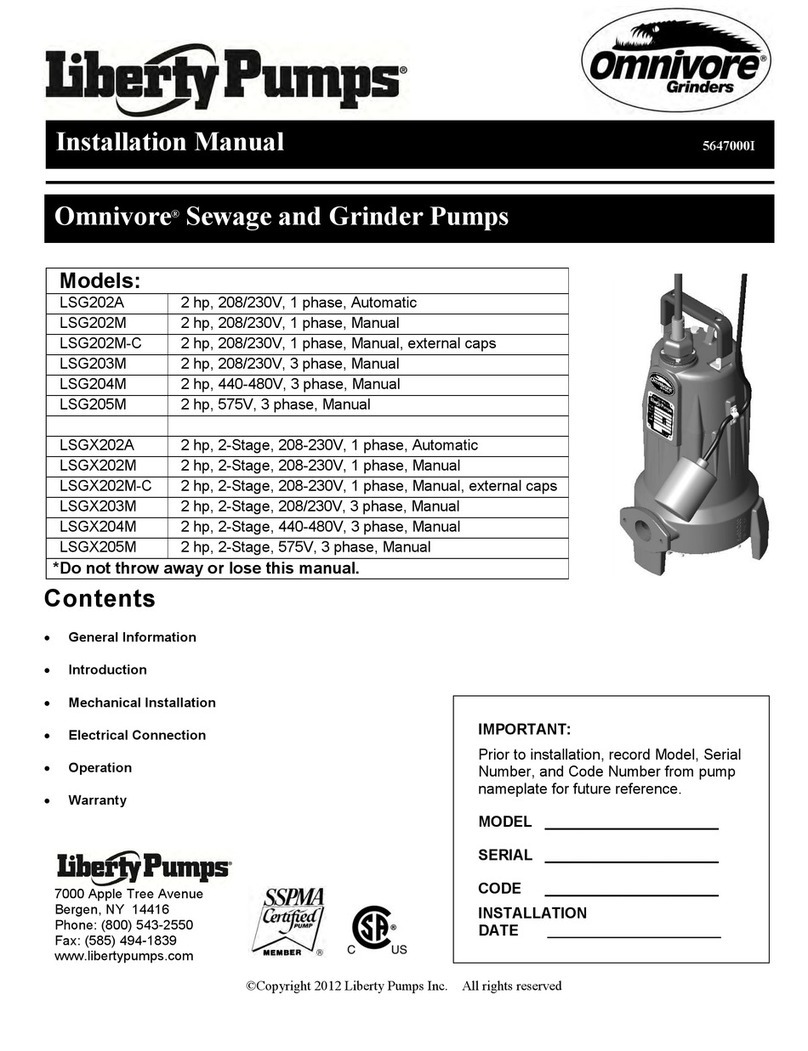
©Copyright 2013 Liberty Pumps Inc. All rights reserved 2
The ProVoretm 1 hp. residential grinder system easily handles solids and sewage waste found in typical residential applications. Its
unique cutter system grinds difficult wastes and then pumps it through a 1-1/2” or 2” discharge line. The ProVoreTM system is supplied
with a 2” discharge outlet. Do not increase this pipe size above 2” as adequate flow rates may not be achieved for proper
operation. Discharge sizes may be reduced to 1-1/2” or 1-1/4”. Please consult factory for proper pipe and system sizing.
Before installation, read the following instructions carefully. Each Liberty pump is individually factory tested to insure proper
performance. Closely following these instructions will eliminate potential operating problems, assuring years of trouble-free service.
Risk of electric shock. To reduce risk of electric shock, always disconnect pump from power source before handling.
The electrical connections and wiring for a pump installation should only be made by qualified personnel.
This pump is supplied with a grounding conductor or a grounding-type attachment plug. To reduce the risk of electric shock,
be certain that the grounding conductor is connected only to a properly grounded control panel or, if equipped with a
grounding-type plug, that it is connected to a properly grounded, grounding-type receptacle.
Do not bypass grounding wires or remove ground prong from attachment plugs.
Do not remove cord and strain relief, and do not connect conduit to pump.
Do not use an extension cord.
This pump requires separate, properly fused and grounded branch circuit. Make sure the power source is properly sized for
the voltage and amperage requirements of the motor, as noted on the pump nameplate.
The electrical outlet or panel shall be within the length limitations of the pump power cord, and at least 4 feet above floor level
to minimize possible hazards from flood conditions.
These pumps are not to be installed in locations classified as hazardous in accordance with the National Electric Code,
ANSI/NFPA 70.
The installation must be in accordance with the National Electric Code and all applicable local codes and ordinances.
Do not use these pumps in water over 140 F.
The Uniform Plumbing Code (UPC) states that sewage systems shall have an audio and visual alarm that signals a
malfunction of the system, to reduce the potential for property damage.
System: The ProVoreTM residential grinder system is shipped from the factory fully assembled.. The following chart lists the grinder
pumps available. Your specific pump is identified by the model number on the nameplate attached to the Pro-Series cover.
Pro 380 Systems ordered with alarm option have an “/A” suffix designating the alarm. “/A2” …ALM-2, “/A2W” …ALM-2W; all Pro 680
systems come with an integral control system with alarm. Also systems are available with an 8” extension to increase the height of the
basin these models are designated with an X8 example: P382X8XPRG101.
Min. Shut-off
Head (no-flow)
45’ (13.5 M)
45’ (13.5 M)
45’ (13.5 M)
45’ (13.5 M)
Note: All P380-Simplex and P680-Duplex Systems are shipped standard with 16 cover bolts and pass the 10’ Stack Test.
Pump and Alarm floats are pre-set on the QuickTree® system at proper operating levels. Do not adjust floats.
Was your system sized by a professional? Minimum fluid flows are required in sewage applications. Consult Factory for proper pump
sizing prior to installation.
QuickTree® Technology: ProVoreTM P380 and P680 systems by Liberty Pumps features QuickTree® float technology. The
QuickTree® system is located under a separate access cover for ease of maintenance and service. Floats for both pump activation
and alarm (if equipped) are mounted on a stainless steel tree (rod), separate from the pump. There is no need to disconnect plumbing
or remove the pump to inspect service or replace floats. QuickTree® floats are preset at the factory for optimum operating levels and
should not be adjusted.




























